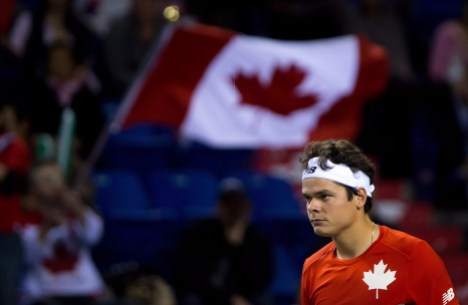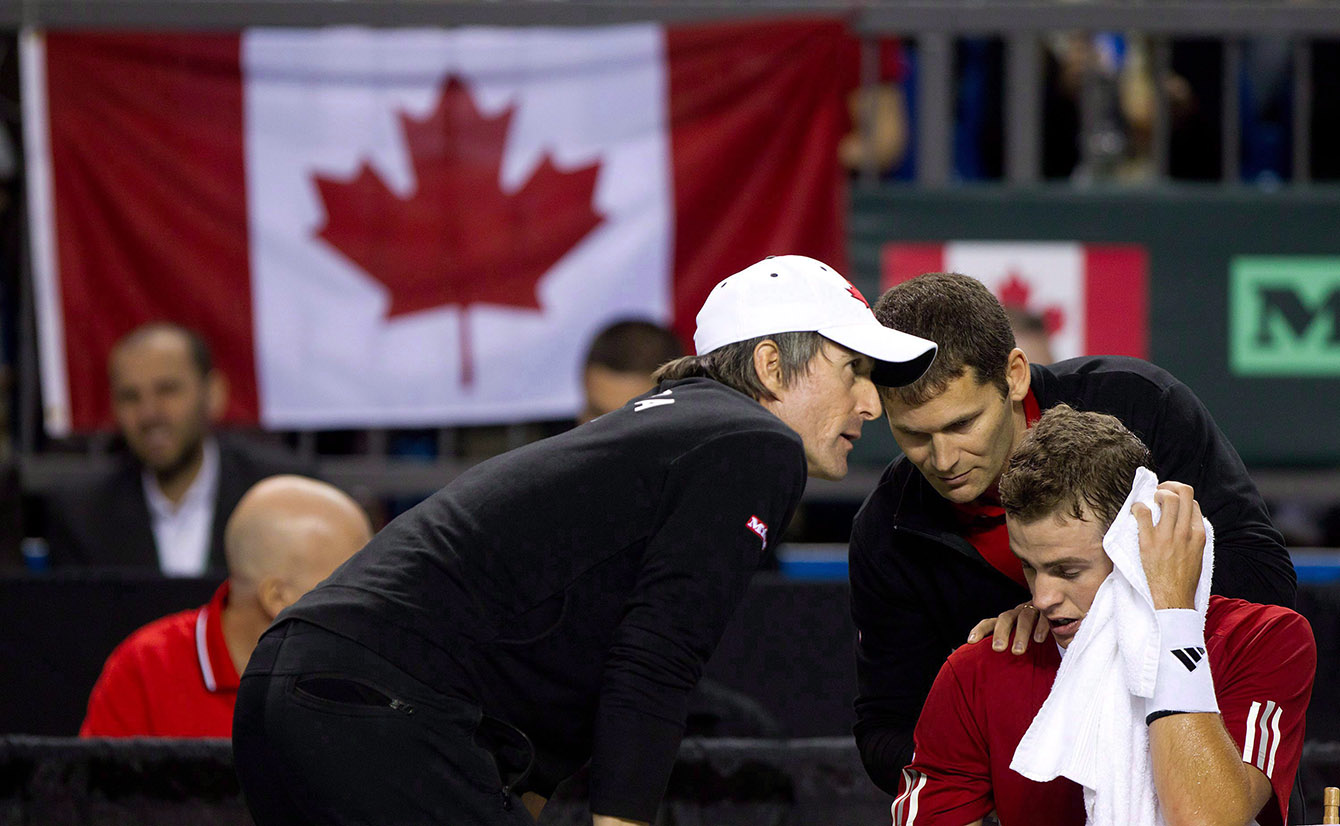5 things you can learn from our Davis Cup team
In 2013, Canada’s run at the Davis Cup stops at the semifinals.
On day 3, Canada’s Vasek Pospisil lost the deciding fifth rubber 6-7, 2-6, 6-7 to Serbia’s Janko Tipsarevic giving the host nation passage to the finals against the Czech Republic.
A day after a rousing 5th set tiebreak victory in doubles play with Daniel Nestor, a first set injury slowed the 23 year old Pospisil enough to lose his second singles match of the weekend.
Credit has to be given to Serbia who entered the day on the brink of elimination but used their weapons well. World No. 1 Novak Djokovic flexed and dispatched Milos Raonic, the fans inside Kombank Arena were loud, and the Serbian team carried the momentum.
Despite the loss, it has been a special year for Canadian men’s tennis.
Over the past 365 days Tennis Canada‘s athletes have risen to a new place in the world. Highlighted by the Davis Cup, an event that has had a serious impact.
Here is what you can learn from our tennis players about amplifying greatness in less than a year.
KNOW WHERE YOU STAND

In mid-September of last year the three singles focused members of Canada’s Davis Cup team had an average ATP ranking of 87. Lead man Milos Raonic was a steady 15th, Vernon-born Vasek Pospisil stood 116th and veteran Frank Dancevic sat 130th. Doubles specialist and Olympic gold medallist Daniel Nestor was top 3.
Also this same month last year Canada would easily dispatch South Africa in a World Group Play-off to join the countries qualified for the 2013 Davis Cup.
The win was in Montreal, a city known for tennis appreciation, but across the country awareness would soon see an increase.
Raonic commented on September 16th, 2012 after the South Africa win, “We have chances to improve, it’s about being hungry, I definitely want it and I’m going to try and instill that if it’s not already in my teammates as much as I can.”
WIN ONE MOMENT AT A TIME
As 2013 arrived so did promotion of a home soil Davis Cup World Group appearance. Tennis fans in Vancouver were again rallied to the westward lying University of British Columbia campus for a glimpse at Canada’s best.
With Rafael Nadal missing, Canada did away with Spain, a tennis victory in a venue usually oriented for varsity hockey.
Leave the banners up and store the court. A shade more than two months later and Canada would return to UBC to beat Italy in the World Group quarters. On this occasion Raonic would be the driving force overcoming 31st-ranked Fabio Fognini and then 18th-ranked Andreas Seppi.
It helps to have a strong leader but the Davis Cup is a rare team event in tennis.
Captain Martin Laurendeau points out the importance of team and taking it one step at a time: “The guys enjoy the team event. When they play it’s great camaraderie. You also get the sense that we all have to win. No one can stand alone, you don’t feel you have to win every one, they understand their role.”
INSPIRE A NATION
Regular tennis fans paid attention when Canada ousted Spain. Casual or new fans certainly must have been attracted to the history-making of both Spain and Italy’s exit and an advancement to the semi-finals.
And paying attention has become easier in recent years with national broadcasts displaying Canada at the Davis Cup.
“It should be more than a few people here sharing the experience, now Canadians expect these moments … “
Laurendeau also appreciates this, “Davis Cup never used to be on TV in Canada, now the last few years it has been on TV every time we’ve played,” he comments.
“It should be more than a few people here sharing the experience, now Canadians expect these moments, when they see fantastic displays and the guys getting fired up it’s a great promotional tour for the game.”
As previous Olympics have proven, Canadians value pride and performance, the sport can vary. Our nation will rise collectively for freestyle skiers, a soccer team, and now tennis players.
And inspiration can flow both ways.
As Raonic observes: “There’s that title of the nation you’re representing on your back. I try to make it as much as any other match on the tour. Even with the Olympics, for myself it’s a big thing. I want to do well as a goal. With Davis Cup being a team event, I think it’s critical to the growth of tennis in Canada. When not only one Canadian is doing well, but 5 or 6, I think it draws attention and many Canadians are succeeding.”
USE EVERY OPPORTUNITY
Throughout a long and grueling tennis season players are faced with so many challenges including an abundance of matches.
For top ranked players such as Raonic, early rounds at tour stops can be a way to fine tune, with more challenging encounters taking place in later rounds.
For others, surviving the early rounds may be a challenge, especially at Grand Slams and depending on the draw a player may not stick around long enough to gain experience against a top ranked opponent.
“When you play well at Davis Cup it can be a big confidence booster.”
The Davis Cup is one opportunity to compete against big hitters in a three-day tournament, great exposure to the sport’s best and chance to improve.
No. 2 Canadian Vasek Pospisil describes this, “As an individual player, when you play well at Davis Cup it can be a big confidence booster which can help when you go back to playing the Tour events. I get a chance to play the No. 1 player in the world this weekend which is an opportunity I haven’t yet had at an ATP event so Davis Cup can often give you some added experience that you wouldn’t normally get.”
Both Pospisil and Raonic prove this. Leveraging the two weekends at UBC this spring, Milos Raonic is now 11th in the world. He even occupied the 10th spot for one week earlier in the season, the first Canadian man to enter the Top 10 realm.
Pospisil has launched himself from 103rd to 41st in the last three months alone. Taking his Davis Cup confidence and plying it in Montreal at the Rogers Cup where he and Raonic faced each other in a historic semi.
NEVER SET LIMITS
There is more work than a few isolated tournaments that goes into becoming a world-beater. But success at this level can’t help but open up a new window of belief in most players.
“Playing the Davis Cup is the ultimate for a tennis professional,” says Laurendeau. Every time they play it’s a great experience. It is very tough conditions with many matches and a lot of sets. When you go through that it lifts up your game.”
There could even be an example in Serbia’s World No. 1 Novak Djokovic.
Like Raonic, Djokovic required less than a year to move from his first top 20 ranking to top 10. He did it back in 2006-2007 and in the following year he played in three more Davis Cup events at various levels going 3-1 in singles play.
Over that same period of time he made his first career Grand Slam final at the US Open and won the 2008 Australian Open ranked 3rd in the world.
Lofty territory, but if you ask Milos it’s on his mind.
“As a Canadian I’m going into new territory and trying to achieve new things. I think I have higher expectations on myself than other people do for me,” he said.
Together, Canada’s Davis Cup team is now a threat. A lifetime of work accelerated over 365 days. And an increasingly captivated nation can’t wait to see what they do next.











